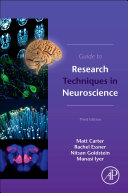Guide to Research Techniques in Neuroscience 3rd Edition by Matt Carter, Rachel Essner, Nitsan Goldstein, Manasi Iyer ISBN 9780128186466 0128186461
$50.00 Original price was: $50.00.$25.00Current price is: $25.00.
Guide to Research Techniques in Neuroscience 3rd Edition by Matt Carter, Rachel Essner, Nitsan Goldstein, Manasi Iyer – Ebook PDF Instant Download/Delivery: 9780128186466 ,0128186461
Full download Guide to Research Techniques in Neuroscience 3rd Edition after payment

Product details:
ISBN 10: 0128186461
ISBN 13: 9780128186466
Author: Matt Carter, Rachel Essner, Nitsan Goldstein, Manasi Iyer
Modern neuroscience research is inherently multidisciplinary, with a wide variety of cutting edge new techniques to explore multiple levels of investigation. This Third Edition of Guide to Research Techniques in Neuroscience provides a comprehensive overview of classical and cutting edge methods including their utility, limitations, and how data are presented in the literature. This book can be used as an introduction to neuroscience techniques for anyone new to the field or as a reference for any neuroscientist while reading papers or attending talks.
- Nearly 200 updated full-color illustrations to clearly convey the theory and practice of neuroscience methods
- Expands on techniques from previous editions and covers many new techniques including in vivo calcium imaging, fiber photometry, RNA-Seq, brain spheroids, CRISPR-Cas9 genome editing, and more
- Clear, straightforward explanations of each technique for anyone new to the field
- A broad scope of methods, from noninvasive brain imaging in human subjects, to electrophysiology in animal models, to recombinant DNA technology in test tubes, to transfection of neurons in cell culture
- Detailed recommendations on where to find protocols and other resources for specific techniques
- “Walk-through” boxes that guide readers through experiments step-by-step
Guide to Research Techniques in Neuroscience 3rd Edition Table of contents:
Chapter 1. Noninvasive Brain Imaging
Structural Brain Imaging Techniques
Functional Brain Imaging Techniques
Functional Imaging Experimental Design and Analysis
Conclusion
Chapter 2. Animal Behavior
Considerations for Choosing and Performing a Behavioral Assay
Rodent Behavioral Paradigms
Drosophila Behavioral Paradigms
C. elegans Behavioral Paradigms
Nonhuman Primate Behavioral Paradigms
Conclusion
Chapter 3. Stereotaxic Surgeries
Determining Coordinates of Brain Regions
Stereotaxic Surgeries in Rodents
Stereotaxic Surgeries in Nonhuman Primates
Conclusion
Chapter 4. Electrophysiology
A Brief Review of the Electrical Properties of Neurons
The Electrophysiology Rig
Categories of Electrophysiology Recordings
Electrophysiology Tissue Preparations
Conclusion
Chapter 5. Microscopy
Essential Principles of Microscopy
Light Microscopy
Fluorescence Microscopy
Electron Microscopy
Preparing and Interpreting Microscopy Data
Conclusion
Chapter 6. Visualizing Nervous System Structure
Tissue Preparation
Visualizing Morphology
Visualizing Gene and Protein Expression
Visualizing Circuitry
Conclusion
Chapter 7. Visualizing and Measuring Neural Dynamics
Static Markers of Activity
Classical Methods of Measuring Extracellular Neurochemistry In Vivo
Biosensors for Visualizing Neural Activity
Biosensors for Visualizing Neurotransmission
Strategies for Visualizing and Measuring Activity from Fluorescent Biosensors
Image Processing in Visualization Experiments
Conclusion
Chapter 8. Manipulating Neural Activity
Experimental Logic of Manipulating Neural Activity
Physical Manipulation
Electrical Manipulation
Pharmacological Manipulation
Genetic Manipulation
Chemogenetic Manipulation
Optogenetic Manipulation
Neuromodulation Techniques Used in Humans
Conclusion
Chapter 9. Identifying Genes and Proteins of Interest
How Genes Encode for Proteins
Genetic Screens
In Silico Screens
Basic Local Alignment Search Tool (BLAST)
Molecular Screens
Conclusion
Chapter 10. Molecular Cloning and Recombinant DNA Technology
Isolating DNA Fragments
Cloning DNA
Identifying DNA
Conclusion
Chapter 11. Gene Delivery Strategies
Physical Gene Delivery
Chemical Gene Delivery
Viral Gene Delivery
Conclusion
Chapter 12. Making and Using Genetically Modified Organisms
Reasons for Engineering a Genetically Modified Organism
Commonly Used Transgenes
Using Promoters to Regulate Gene Expression
General Strategies for Genome Modification
Engineering Genetically Modified Organisms
Binary Expression Systems
Disrupting Gene Products
Conclusion
Chapter 13. Cell Culture Techniques
Cell Culture Equipment and Reagents
Immortalized Cell Lines
Primary Cell and Tissue Culture
Stem Cell Cultures
Manipulating Cells in Culture
Conclusion
Chapter 14. Intracellular Signaling and Biochemical Assays
Introduction to Signal Transduction and Intracellular Signaling
Fundamental Tools Used to Study Proteins
Investigating Protein Expression
Investigating Protein-Protein Interactions
Investigating Posttranslational Modifications
Investigating Protein–DNA Interactions
Conclusion
Glossary
Index
People also search for Guide to Research Techniques in Neuroscience 3rd Edition:
research techniques in neuroscience
3rd ed. of guide to research techniques in neuroscience
research guide examples
neuroscience methods 101
neuroscience research methods
Tags: Matt Carter, Rachel Essner, Nitsan Goldstein, Manasi Iyer, Research Techniques, Neuroscience
You may also like…
Computers - Databases
Trino: The Definitive Guide 2nd Edition by Matt, Manfred, Martin 9781098137236 109813723X
Medicine - Neuroscience
Reference - Writing
A Pocket Guide to Scientific Writing in Aquaculture Research 1st Edition Yossa
Uncategorized
Computers - Internet & World Wide Web
CEH Certified Ethical Hacker All-in-One Exam Guide, 5th Edition Matt Walker
Uncategorized
Travel - United States of America - Travel











